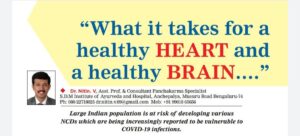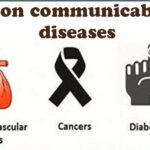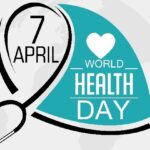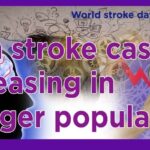What it takes for a healthy HEART and a healthy BRAIN ? Large Indian population is at risk of developing various NCDs which are being increasingly reported to be vulnerable to COVID-19 infections.


India has a high prevalence of noncommunicable diseases (NCDs), which can be lowered by regular physical activity. 20% and 37% of the population in India are not active or mildly active, respectively, and thus 57% of the surveyed population do not meet the physical activity regimen recommended by the World Health Organization. This puts a large Indian population at risk of developing various NCDs, which are being increasingly reported to be vulnerable to COVID-19 infections.
Even more sobering:
Many adults don’t get any activity at all, aside from what they need to make it through the day. And as we age, more and more of us stop moving. While you likely know that long-term inactivity weakens your bones, muscles and nerves, you may not realize that it can damage your heart and brain, too. This, in turn, raises your odds of dementia and heart disease, among other conditions, and can lead to early death.
But research suggests that getting exercise can help keep these organs healthy and delay or prevent their decline. And if you regularly work up a sweat over a number of years? All the better.
How exercise benefits the heart…
As you progress through middle age, your heart gradually begins to weaken. Its walls get thicker and less flexible, and your arteries become stiffer. This raises your risk for high blood pressure (hypertension) and other heart problems, including heart attack and heart failure. And if you’re sedentary, that risk goes up even more.
When you exercise, your heart beats faster, increasing blood flow and supplying your body with necessary oxygen. The more you work out, the stronger your heart gets and the more elastic your blood vessels become. This helps you maintain a lower blood pressure and decreases your chances of developing many cardiovascular problems.
It’s aerobic exercise (also called cardio) that really does the trick. Research suggests that consistent, long-term moderate or vigorous cardio training may be most helpful, though any physical activity promotes good heart health. “It can be anything like brisk walk, running, cycling, swimming and yoga – “Anything that builds up that heart rate.”
Getting in shape benefits your heart in other ways, too, by helping to neutralize the risk factors linked to heart disease. Exercise is associated with:
- A reduction in inflammation.
- An increase in HDL (“good” cholesterol) and decrease in LDL (“bad” cholesterol).
- Maintaining a healthy weight and staving off obesity.
And though more studies are needed, research increasingly shows that exercise can boost your heart health, no matter your age.
How exercise benefits the brain…
What’s good for your heart is generally good for your brain – and research shows, breaking a sweat on a regular basis can boost brain health in several ways.
First, exercise is tied to improved cognition, which includes better memory, attention and executive function—things like controlling emotions and completing tasks. It can enhance the speed with which you process and react to information, too, along with your capacity to draw knowledge and experiences from your past.
Getting physical is also linked to slower age-related cognitive decline, where we gradually lose our thinking, focus and memory skills. In other words, “if you like where you are, it’s a good idea to continue to exercise because that may at least help you retain your current cognitive function.”
And though the jury is still out on whether it improves symptoms, exercise may help prevent or delay dementia, including Alzheimer’s disease. For example, one 2017 review in The Journals of Gerontology: Biological Sciences found that activity was associated with a lower risk of Alzheimer’s down the line. The link was strongest for people who purposely exercised in their spare time, rather than those who had physically active jobs. This suggests mental benefits may depend on your chosen activity, in addition to the time you put into it.
Also Read: Do you know the best ways to cut down the risk of Alzheimer’s Dementia?
How does exercise do all this?
Scientists aren’t completely sure. It’s the thought that working out improves blood flow and oxygen delivery to the brain, helping it function better. Some research indicates it prevents shrinkage of the hippocampus – the part of the brain crucial for learning and remembering things. Experts also believe it stimulates chemical activity in the brain that could contribute to better cognition.
Finally, exercise may help lower your chances of developing other conditions connected to dementia, including cardiovascular disease.
When can you start?
No matter our age, pretty much all of us can gain from exercise. There is evidence to suggest that doing more vigorous exercise earlier in life is more beneficial, but it’s never too late to start because everyone benefits from doing some sort of movement or physical activity.
In addition to its rewards for the heart and brain, working out:
- Boosts your mood and energy.
- Helps prevent internal injuries.
- Lowers your risk of other diseases associated with aging, like arthritis, diabetes and hypertension.
- Helps you remain independent.
“Ayurveda – The science of life”, believes in following disciplined daily regimen (dinacharya) and seasonal regimen (rutucharya) to enhance the quality and quantity of life. Vyayama (physical exercises) are an integral part of our daily regimen, and Ayurveda strictly advises exercises to half of our strength. Exercising beyond our capability causes more stress to the cardiac system and might lead to sudden collapse (syncope / death).
However, it is not advisable to begin tough exercises after 45 and it is always good to get trained before any exercise because, “how to exercise is more important than just to exercise.”
Your regimen should also incorporate some strength training, along with balance and flexibility moves (best example is YOGA). They can help keep you mobile and reduce injuries – especially from falls, which are often catastrophic for older people’s health.
Watch the video: YOGA the Journey of True Self
Ease into your routine…
Of course, older adults should always speak with a healthcare professional before beginning any new regimen, especially if you have a chronic condition, like a heart disease. Your healthcare professional can help you decide on a safe, effective routine attuned to your fitness level.
Whatever you do, you must decide if planting yourself on the sofa is worth your long-term brain and heart health: As I emphasize to patients, ‘A rolling stone gathers no moss.’
Also Read: Inter-Relation Between Physical and Mental Health


Dr. Nitin. V
Asst. Prof. & Consultant Panchakarma Specialist
S.D.M Institute of Ayurveda and Hospital
Anchepalya, Musuru Road Bengaluru-74
Ph: 080-22718025
Email: dr.nitin.v.89@gmail.com Mob: +91 99018 65656











